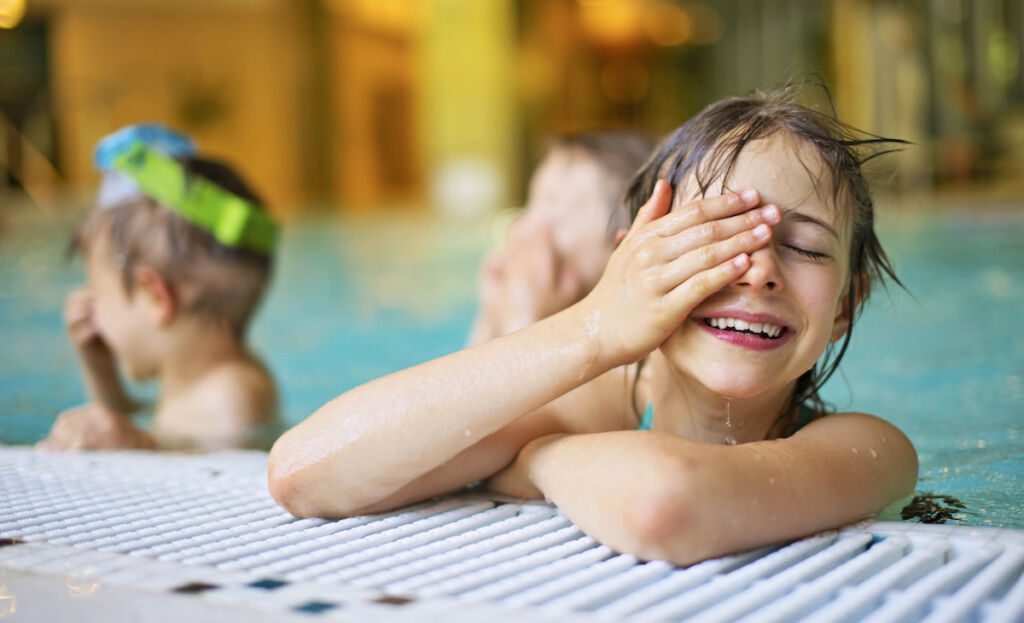How to Lower Combined Chlorine for a More Comfortable & Healthier Swimming Environment
Your aquatic facility is open for summer, and while you’re checking off your to-do list to welcome swimmers back, do you have a plan for inevitable combined chlorine in the pool water? If you want to offer guests a comfortable, healthy and safe swimming experience, getting control over your swimming pools combined chlorine is critical.
Why You Want to Lower Combined Chlorine
The less combined chlorine in your pool water, the better your air and water quality will be. Whether it’s in the air or water, exposure to high combined chlorine levels from your pool water can lead to an uncomfortable swimming experience and health issues down the line.
For your swimmers and staff, combined chlorine can lead to:
- Dry, itchy or irritated skin and rashes
- Burning red eyes
- Brittle hair
- Damaged bathing suits
- “Pool” chemical odor
- Respiratory health issues
- “Chlorine Cough,” or a persistent cough
- Allergies
- Bronchitis
- Asthma
- Lifeguard Lung
So, in order to keep patrons’ trust and provide a healthy, enjoyable swimming experience, it’s vital to keep your combined chlorine levels under control.
What Is Combined Chlorine?
Contrary to popular belief, that unpleasant swimmer irritation and heavy “pool smell” that lingers in indoor pools isn’t the result of chlorine, but rather the formation of combined chlorine, also known as chloramines, and other disinfection by-products (DBPs).
When chlorine in the pool water interacts with organic material, like lotion, sweat or perfume in the water, it produces combined chlorine and other DBPs. Our bodies carry this organic material along with us everywhere we go – regardless of how clean we look or feel. When swimmers jump in the pool their organic materials bind with the chlorine in the water and create harmful combined chlorine and other DBPs.
How To Measure Combined Chlorine
If you’re a pool operator, you probably know the three types of chlorine, including free chlorine, combined chlorine and total chlorine. To measure combined chlorine levels in your aquatics facility’s pool water, use the following simple formula:
Total Chlorine (TC) – Free Chlorine (FC) = Combined Chlorine (CC)
Your aquatics facility may have a controller that can do this quick math for you, or you can use a commercial grade FAS-DPD test kit to get the total chlorine and free chlorine levels then finish with the simple subtraction.
Now that you know why combined chlorine is crucial to address, what it is and how to measure it, let’s dive into how to lower combined chlorine in your pool water.
How to Lower Combined Chlorine in Swimming Pools
1. Superchlorinate the Water
To keep up with the bather load from swimming lessons, competitions and other activities, most aquatics operators will superchlorinate pool water to address combined chlorine. Superchlorination is the process of putting 10 times the amount of chlorine to combined chlorine in the water. It takes 25 parts of combined chlorine to do the work of just one part of free chlorine. So, once you’ve calculated the level of combined chlorine in the pool, you will have to add about 10 times that amount of free chlorine to get rid of it using the superchlorination method.
2. Apply a Non-Chlorine Shock
Non-chlorine shocking is the process of adding more oxidizer to the water that is not in chlorine form. Potassium monopersulfate, or MPS, is the most common oxidizer used for non-chlorine shocking, which helps with oxidants but doesn’t help with disinfection.
Enzymes are another popular choice for a non-chlorine shock because they metabolize organic material, like lotions, body oils and perfumes. However, similar to a MPS shock, enzymes do not directly reduce combined chlorine, they simply increase the efficiency of chlorine.
3. Use Supplemental or Secondary Sanitation
For a healthier alternative solution, top aquatics facilities add secondary and supplemental pool sanitation systems to their primary disinfection method, like chlorine or bromine. Secondary and supplemental sanitation power essentially does what chlorine or bromine can’t – reduce combined chlorine and protect against chlorine-resistant microorganisms, like Cryptosporidium.
UV Pool Sanitation
UV pool sanitation systems inactivate contaminants by flowing water over a UV, or ultraviolet, lamp in the pool plumbing, but it does not oxidize it. Without oxidation, UV typically needs additional chlorine to destroy contaminants, remove pathogens, and improve clarity or overall water quality. Additionally, research has shown that UV sanitation can increase the rate of free chlorine consumption.
From a cost perspective, UV is typically the most expensive secondary sanitation method to operate because of its installation cost, high energy consumption, required lamp handling, system disassembly, special tools and annual downtime for professional servicing.
Ozone Pool Sanitation
Ozone pool sanitation systems operate by injecting ozone (O3) gas into the pool plumbing to oxidize and disinfect water. The ozone gas dissolves in the water to kill and oxidize microorganisms, destroy organic compounds and break down chloramines. Since ozone is hazardous, it requires degassing to protect swimmer safety, pool equipment, surfaces and prevent accumulation in pump rooms. Additionally, ozone gas can be corrosive to pool equipment and typically doesn’t scale well with large bodies of water with high bather loads, like water parks or competition pools.
To Hear From an Aquatics Operator Who Switched From UV to Hydroxyl-Based AOP Pool Sanitation, Watch the Video Here.
UV+Ozone AOP Pool Sanitation
UV+ozone Advanced Oxidation Process (AOP) pool sanitation systems use two technologies to try to boost highly oxidative hydroxyl radicals, while creating ozone in the process. UV+ozone systems work by dissolving ozone gas in the water and then passing it through a chamber with a germicidal UV lamp. This process causes a chemical reaction that creates hydroxyls, which oxidize contaminants in the water and then quickly convert back into oxygen.
By combining UV and ozone pool sanitation, the system requires maintenance for both of the two technologies. Maintaining a UV+ozone AOP pool system can take up to 12 hours per year, and requires lamp handling, system disassembly, special tools, annual downtime and professional servicing that’s needed to maintain a UV pool system.
Hydroxyl-Based AOP Pool Sanitation
Hydroxyl-Based AOP pool sanitation systems create the same hydroxyl radicals as UV+ozone AOP pool systems, but at a much faster rate. Rather than combining two systems, Hydroxyl-Based AOP pool treatment pulls in ambient air around the system and treats it with a patented process and directly injects excited atomic oxygen (O1) directly into the pool plumbing to produce high concentrations of hydroxyl radicals. Independent aquatic facility case studies have shown that Hydroxyl-Based AOP pool sanitation systems can reduce DBPs by up to 90 percent, while allowing commercial pools to reduce chlorine and other chemical costs by up to 30 to 50 percent.
By directly injecting treated air into pool plumbing, Hydroxyl-Based AOP pool systems make installation more effective and efficient without complicated pool plumbing configurations, professional servicing or annual downtime. With sanitation power that can scale, Hydroxyl-Based AOP pool sanitation can treat everything from spas to large wave pools and water parks.
Choosing the Right Method For Your Facility
While there are several options available to lower combined chlorine, secondary or supplemental sanitizers are a long-lasting, effective solution. Among the four top secondary or supplemental sanitizers, Hydroxyl-Based AOP outperforms the others and allows you to be proactive instead of reactive to combined chlorine.
Still not convinced? In an independent case study, two recreational facilities in Los Angeles compared how well medium pressure UV and Hydroxyl-Based AOP pool sanitation systems reduced harmful combined chlorine and DBPs. While both methods were successful, the study found that Hydroxyl-Based AOP had 55 percent better combined chlorine reduction and 22% better DBP reduction than medium pressure UV.
To See The Full Results of the AOP & UV Comparison Case Study: Combined Chlorine & DBP Reduction, Click Here.






